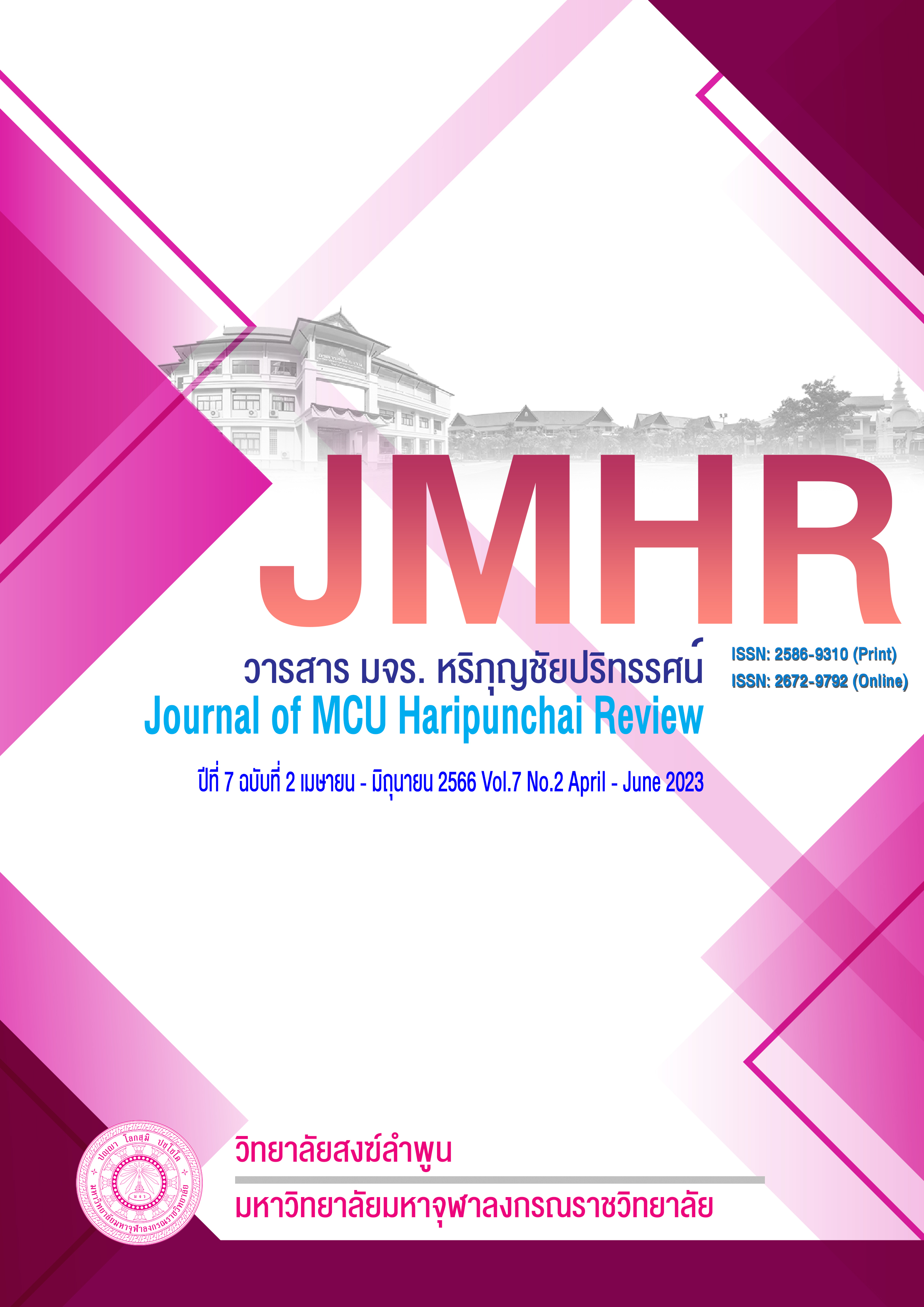A Factor Analysis of Characteristics of Good Student Teachers in 21st Century of Sakon Nakhon Rajabhat University
Main Article Content
Abstract
The purposes of this research were 1) to study the factor of characteristics of good student teachers in 21st century of Sakon Nakhon Rajabhat University and 2) to perform a confirmatory factor analysis of characteristics of good student teachers in 21st century of Sakon Nakhon Rajabhat University. The research methodology has two phases. The first phase was the factor study, and the second phase was a confirmatory factor analysis. The sample consisted of 420 student teachers of Sakon Nakhon Rajabhat University in academic year 2022. They were selected by stratified random sampling. The research instrument was the 5–point rating scale questionnaire. Its IOC index at .80 - 1.00, the discrimination power index between .28 - .73, and the reliability index at .96. The statistics used in this research were frequency, percentage, mean, standard deviation, and factor analysis with statistic program.
The research findings were: 1) the factor of characteristics of good student teachers in 21st century of Sakon Nakhon Rajabhat University consisted of 10 factors and 2) a confirmatory factor analysis on hypothesis model consistent with empirical data. The Chi-square = 0.92, df = 11, p-value = 0.99, RMSEA = 0.00, GFI = 1.00, AGFI = 1.00. The factor loadings were arranged from the highest to the lowest values followed these aspects; leadership, endeavor and dedication, learning management ability, teamwork, good communication, adjusting ability, good personality, having morals and ethics, willing to learn, and a spiritual of teachers. All 10 factors are able to describe characteristics of good student teachers in 21st century of Sakon Nakhon Rajabhat University. The percentages were 46, 43, 41, 41, 40, 39, 37, 34, 33 and 33 respectively.
Article Details

This work is licensed under a Creative Commons Attribution-NonCommercial-NoDerivatives 4.0 International License.
References
กองนโยบายและแผน, สำนักงานอธิการบดี, มหาวิทยาลัยราชภัฏสกลนคร. (2565). แผนยุทธศาสตร์มหาวิทยาลัยราชภัฏสกลนคร ระยะ 5 ปี พ.ศ. 2565-2569. [ออนไลน์]. แหล่งข้อมูล. https://plan.snru.ac.th/topics/17722. [พฤศจิกายน 2565].
กระทรวงศึกษาธิการ. (2560). แผนการศึกษาแห่งชาติ พ.ศ. 2560 – 2579. กรุงเทพฯ : สำนักงานเลขาธิการสภาการศึกษา.
คณะครุศาสตร์, มหาวิทยาลัยราชภัฏสกลนคร. (2565). สารสนเทศคณะครุศาสตร์ : จำนวนนักศึกษาคณะครุศาสตร์.[ออนไลน์]. แหล่งข้อมูล. https://edu.snru.ac.th/topics/5789. [พฤศจิกายน 2565].
จันทร์เพ็ญทองดี กมลทิพย์ ศรีหาเศษ และสุวิมล ติรกานันท์. (2564). การวิเคราะห์องค์ประกอบคุณลักษณะของครูที่ดีในทัศนะของนักเรียนระดับมัธยมศึกษา สังกัดสำนักงานเขตพื้นที่การศึกษามัธยมศึกษา เขต 2. วารสารสถาบันวิจัยญาณสังวร, 12(1), 1-12.
นงลักษณ์ วิรัชชัย. (2542). โมเดลลิสเรล: สถิติวิเคราะห์สำหรับการวิจัย. (พิมพ์ครั้งที่ 3). กรุงเทพฯ : จุฬาลงกรณ์มหาวิทยาลัย.
บุญชม ศรีสะอาด. (2554). การวิจัยเบื้องต้น. (พิมพ์ครั้งที่ 10). กรุงเทพฯ : สุวีริยาสาส์น.
ประภัสสร ไชยชนะใหญ่ และวุฒิภัทร มูลศรี. (2562). บทบาทครู : การพัฒนาการเรียนรูภายใตสังคมแหงการเปลี่ยนแปลง. วารสาร มจร. หริภุญชัยปริทรรศน์, 3(1), 41-50.
ภัณฑิรา ดวงจินดา และศิริเดช สุชีวะ. (2562). การวิเคราะห์องค์ประกอบและตัวชี้วัดสมรรถภาพของครูวิทยาศาสตร์ ระดับมัธยมศึกษา. An Online Journal of Education, 13(3), 401–412.
ภานุมาศ จินารัตน์และพนมพร ช่วงชิง. (2565). แนวทางการพัฒนาคุณลักษณะครูที่ดีที่ส่งผลต่อการดำรงชีวิต. วารสาร มจร อุบลปริทรรศน์, 7(2), 663-672.
วาโร เพ็งสวัสดิ์. (2551). วิธีวิทยาการวิจัย. กรุงเทพฯ: สุวีริยาสาส์น.
_________. (2560). การวิจัยทางการบริหารการศึกษา. (พิมพ์ครั้งที่ 2). สกลนคร: สมศักดิ์การพิมพ์.
วิจารณ์ พานิช. (2555). วิถีสร้างการเรียนรู้เพื่อศิษย์ ในศตวรรษที่ 21. มูลนิธิสดศรี-สฤษดิ์วงศ์. กรุงเทพฯ : โรงพิมพ์ บริษัท ตถาตา พับลิเคชั่น จำกัด.
หลักสูตรประกาศนียบัตรบัณฑิต, สาขาวิชาชีพครู. (2566). หลักสูตรประกาศนียบัตรบัณฑิต สาขาวิชาชีพครู (หลักสูตรปรับปรุง พ.ศ. 2566). สกลนคร : คณะครุศาสตร์ มหาวิทยาลัยราชภัฏสกลนคร.
เอกลักษณ์ เพียสา จำรัส กุลพันธ์และทิพย์ โอษฐงาม. (2564). การพัฒนาตัวบงชี้คุณภาพชีวิตในการทำงานของครูในโรงเรียนพระปริยัติธรรมแผนกสามัญศึกษาในภาคตะวันออกเฉียงเหนือ. วารสารครุศาสตร มหาวิทยาลัยราชภัฏมหาสารคาม, 18(3), 233-244.


